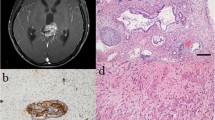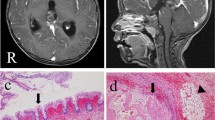Abstract
Introduction
Residual radiologically progressive masses following multimodality treatment of malignant mixed intracranial germ cell tumors are described. Often these enlarge, and this is called the growing teratoma syndrome. A similar phenomenon during radiotherapy alone has not been described.
Subjects and methods
A 5-year old boy presented with features of raised intracranial pressure. Imaging revealed a posterior third ventricular mass, which was biopsied endoscopically.
Results
A review of the scanty tissue was suggestive of a pineal parenchymal tumor, and hence radiation was planned. After just ten fractions, he developed rapid neurological deterioration. Repeat imaging raised a possibility of a teratomatous tumor. He underwent emergency excision. However, he had a stormy postoperative course and succumbed to deep venous infarction. Histology revealed a purely mature teratoma.
Conclusion
Though a growing teratoma syndrome has been described following chemotherapy, no such report while on radiation exists. Ours could be the first such reported case. We discuss the possible mechanisms with a review of the literature.




Similar content being viewed by others
References
Afifi HY, Bosl GJ, Burt ME (1997) Mediastinal growing teratoma syndrome. Ann Thorac Surg 64(2):359–362. doi:10.1016/S0003-4975(97)00581-X
André F, Fizazi K, Culine S, Droz J, Taupin P, Lhommé C, Terier-Lacombe M-J, Theodore C (2000) The growing teratoma syndrome: results of therapy and long-term follow-up of 33 patients. Eur J Cancer 36(11):1389–1394. doi:10.1016/S0959-8049(00)00137-4
Aydin F, Ghatak NR, Radie-Keane K, Kinard J, Land SD (1992) The short-term effect of low-dose radiation on intracranial germinoma. A pathologic study. Cancer 69(9):2322–2326. doi:10.1002/1097-0142(19920501)69:9<2322::AID-CNCR2820690920>3.0.CO;2-8
Bi WL, Bannykh SI, Baehring J (2005) The growing teratoma syndrome after subtotal resection of an intracranial nongerminomatous germ cell tumor in an adult: case report. Neurosurgery 56(1):188
Bruce JN, Stein BM Surgical Management of Pineal Region Tumors (1995) Acta Neurochir (Wien) 134:130–i 35
Chiu CD, Chung WY, Pan DH, Wong TT, Shih YH, Lee LS (2006) Gamma knife radiosurgery for intracranial mature teratoma-long-term results and review of literature. Surg Neurol 65(4):343–351. doi:10.1016/j.surneu.2005.07.075
Choi JU, Kim DS, Chung SS, Kim TS (1998) Treatment of germ cell tumors in the pineal region. Childs Nerv Syst 14(1–2):41–48. doi:10.1007/s003810050173
Friedman JA, Lynch JJ, Buckner JC, Scheithauer BW, Raffel C (2001) Management of malignant pineal germ cell tumors with residual mature teratoma. Neurosurgery 48(3):518–522. doi:10.1097/00006123-200103000-00011
Hanna A, Edan C, Heresbach N, Ben Hassel M, Guegan Y (2000) Expanding mature pineal teratoma syndrome. Case report. Neurochirurgie 46(6):568–572 Article in French
Hoffman HJ, Otsubo H, Hendrick EB, Humphreys RP, Drake JM, Becker LE et al (1991) Intracranial germ-cell tumors in children. J Neurosurg 74(4):545–551
Inoue Y, Takeuchi T, Tamaki M, Nin K, Hakuba A, Nishimura S (1979) Sequential CT observations of irradiated intracranial germinomas. AJR Am J Roentgenol 132:361–365
Itani Y, Kawa M, Toyoda S, Yamagami K, Hiraoka K (2002) Growing teratoma syndrome after chemotherapy for a mixed germ cell tumor of the ovary. J Obstet Gynaecol Res 28(3):166–171. doi:10.1046/j.1341-8076.2002.00032.x
Lee AC, Chan GC, Fung CF, Leung SY, Lau YL (1995) Paradoxical response of a pineal immature teratoma to combination chemotherapy. Med Pediatr Oncol 24:53–57. doi:10.1002/mpo.2950240112
Logothetis CJ, Samuels ML, Trindade A, Johnson DE (1982) The growing teratoma syndrome. Cancer 50:1629–1635. doi:10.1002/1097-0142(19821015)50:8<1629::AID-CNCR2820500828>3.0.CO;2-1
Matsutani M (2004) Clinical management of primary central nervous system germ cell tumors. Semin Oncol 31(5):676–83
Matsutani M, Sano K, Takakura K, Fujimaki T, Nakamura O, Funata N et al (1997) Primary intracranial germ cell tumors: a clinical analysis of 153 histologically verified cases. J Neurosurg 86(3):446–455
Noudel R, Vinchon M, Dhellemmes P, Litré CF, Rousseaux P (2008) Intracranial teratomas in children: the role and timing of surgical removal. J Neurosurg Pediatr 2(5):331–338. doi:10.3171/PED.2008.2.11.331
O’Callaghan AM, Katapodis O, Ellison DW, Theaker JM, Mead GM (1997) The growing teratoma syndrome in a nongerminomatous germ cell tumor of the pineal gland: a case report and review. Cancer 80(5):942–947. doi:10.1002/(SICI)1097-0142(19970901)80:5<942::AID-CNCR16>3.0.CO;2-W
Ogawa K, Toita T, Nakamura K, Uno T, Onishi H, Itami J, Shikama N, Saeki N, Yoshii Y, Murayama S (2003) Treatment and prognosis of patients with intracranial nongerminomatous malignant germ cell tumors: a multiinstitutional retrospective analysis of 41 patients. Cancer 15;98(2):369–376
Peltier J, Vinchon M, Baroncini M, Kerdraon O, Dhellemmes P (2008) Bifocal mixed germ-cell tumor with growing teratoma syndrome and metachronous mature metastases: case report. J Neurooncol 90(1):111–115. doi:10.1007/s11060-008-9640-3
Rustin GJ, Newlands SE, Bagshawe KD, Begent RHJ, Crawford SM (1986) Successful management of metastatic and primary germ cell tumors in the brain. Cancer 57:2108–2113. doi:10.1002/1097-0142(19860601)57:11<2108::AID-CNCR2820571103>3.0.CO;2-Z
Shaffrey ME, Lanzino G, Lopes MB, Hessler RB, Kassell NF, VandenBerg SR (1996) Maturation of intracranial immature teratomas. Report of two cases. J Neurosurg 85(4):672–676
Yagi K, Kageji T, Nagahiro S, Horiguchi H (2004) Growing teratoma syndrome in a patient with a non-germinomatous germ cell tumor in the neurohypophysis—case report. Neurol Med Chir (Tokyo) 44(1):33–37. doi:10.2176/nmc.44.33
Author information
Authors and Affiliations
Corresponding author
Rights and permissions
About this article
Cite this article
Moiyadi, A., Jalali, R. & Kane, S.V. Intracranial growing teratoma syndrome following radiotherapy—an unusually fulminant course. Acta Neurochir 152, 137–142 (2010). https://doi.org/10.1007/s00701-009-0332-3
Received:
Accepted:
Published:
Issue Date:
DOI: https://doi.org/10.1007/s00701-009-0332-3




